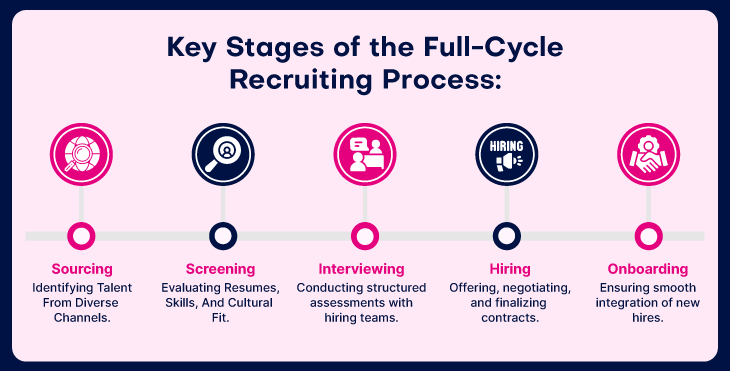Topics: Full Cycle Recruiting, Full Cycle Recruitment, full life cycle recruiting process
Posted on August 29, 2025
Written By Ranjana Singh

For many recruitment firms, the biggest challenge isn’t finding open roles, it’s filling them quickly and profitably. Also, when these hiring processes are uncoordinated, it creates delays, miscommunication, and candidate drop-offs.
And most often it leads to lost revenue, frustrated clients, and reduced margins.
This was exactly the situation one recruitment firm faced. Despite strong demand from healthcare clients, placements were getting delayed because sourcing, screening, and onboarding were handled by separate teams with little coordination. Every missed placement meant leaving revenue on the table.
By leveraging full cycle recruitment outsourcing services — where a single recruiter managed the entire end-to-end hiring process — the firm turned things around. The result: 31 successful placements and £300K in gross margin within six months.
Want to know how to achieve similar results? In this blog, we’ll show you how, and also break down:
Full-cycle recruiting (also known as full-cycle recruitment management) is the practice of managing the entire hiring lifecycle through one unified process. Instead of splitting responsibilities across different teams, one recruiter or team oversees the entire journey—bringing greater accountability, consistency, and speed.
Sourcing: Actively searching for potential candidates across multiple channels such as job boards, social media, databases, and referrals to build a strong talent pipeline.
Screening: Reviewing resumes, verifying qualifications, and assessing skills, experience, and cultural fit to shortlist the most suitable candidates.
Interviewing: Coordinating and conducting structured interviews, tests, or assessments in collaboration with hiring managers to evaluate candidate capabilities.
Hiring: Extending job offers, negotiating terms, and managing the contract or agreement process to secure the best talent.
Onboarding: Guiding new hires through orientation, documentation, and training to ensure a seamless transition into their new role and workplace culture.

The UK is facing a dual challenge: talent shortages in healthcare, engineering, and IT, alongside rising costs for staffing firms.
A staffing firm partnered with QX Global Group after struggling with slow placements, limited candidate pipelines, and a lack of structured processes. They needed a recruitment model that could improve delivery speed, accountability, and ROI.
QX introduced a full-cycle recruiting model, where dedicated recruiters managed the entire hiring journey — from sourcing and screening through to placement and onboarding. Supported by automation, offshore delivery, and structured SOPs, the process created consistency, reduced turnaround times, and improved candidate engagement.
This recruitment success story shows how adopting a full-cycle recruiting process can transform hiring outcomes, strengthen ROI, and deliver measurable growth.
Transitioning to full-cycle recruitment requires both technology and culture change. Here’s how you can implement full-cycle recruiting in your firm.
With the right talent acquisition strategy, full-cycle recruiting can become a game-changer for staffing firms.
Full-cycle recruiting is more than a hiring method, it’s a strategic hiring impact model that drives better results for clients and candidates alike. As this case study shows, implementing a structured end-to-end hiring process with QX Global Group, can lead to substantial outcomes: 31 placements, £300K margin, and long-term business growth. For UK recruitment firms, adopting this model is no longer optional—it’s a necessity for achieving sustainable success.
Full-cycle recruiting covers the entire end-to-end hiring process, from sourcing to onboarding, managed by one recruiter or team for accountability and efficiency.
Full-cycle recruiting improve placement outcomes By unifying all full cycle recruiting steps, it ensures faster hiring, consistent candidate engagement, and higher placement success.
In our case study, the full-cycle recruiting model successfully delivered 31 placements across both permanent and contract positions. These included a mix of specialist and high-demand roles, demonstrating the efficiency of a unified, end-to-end hiring process.
Full-cycle recruiting is effective for high-volume hiring because it streamlines communication, leverages automation, and reduces duplication—critical for managing high applicant volumes.
The key stages in full-cycle recruiting process include sourcing, screening, interviewing, hiring, and onboarding.
QX integrates implement full-cycle recruiting for clients by leveraging automation, offshore recruitment support, and structured workflows to maximize ROI, speed, and placement success.
Enjoyed our blog? Discover more about how our recruitment outsourcing process can slash your costs by up to 60%! Take the next step—book a call by entering your details.
Originally published Aug 29, 2025 04:08:21, updated Sep 16 2025
Topics: Full Cycle Recruiting, Full Cycle Recruitment, full life cycle recruiting process